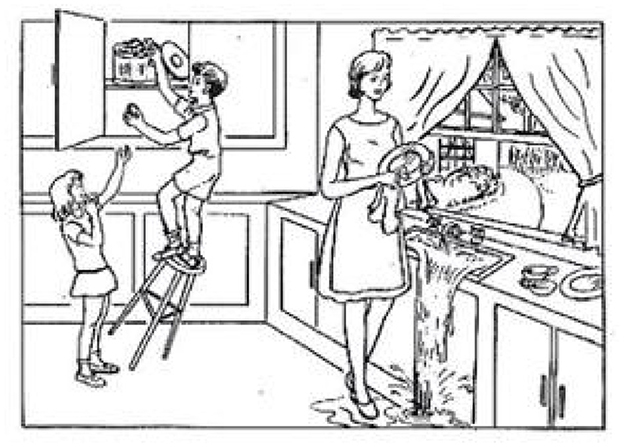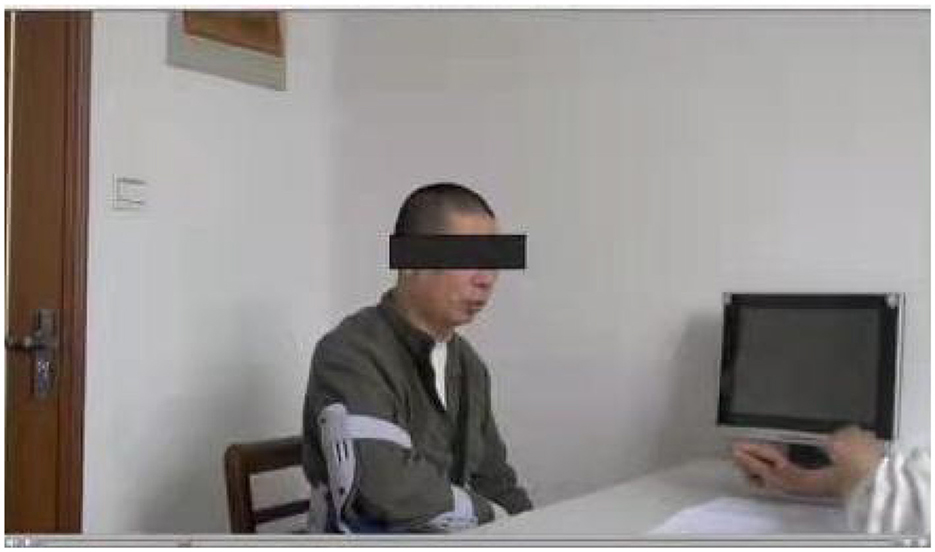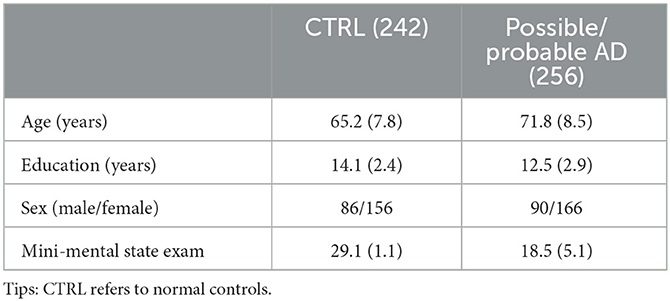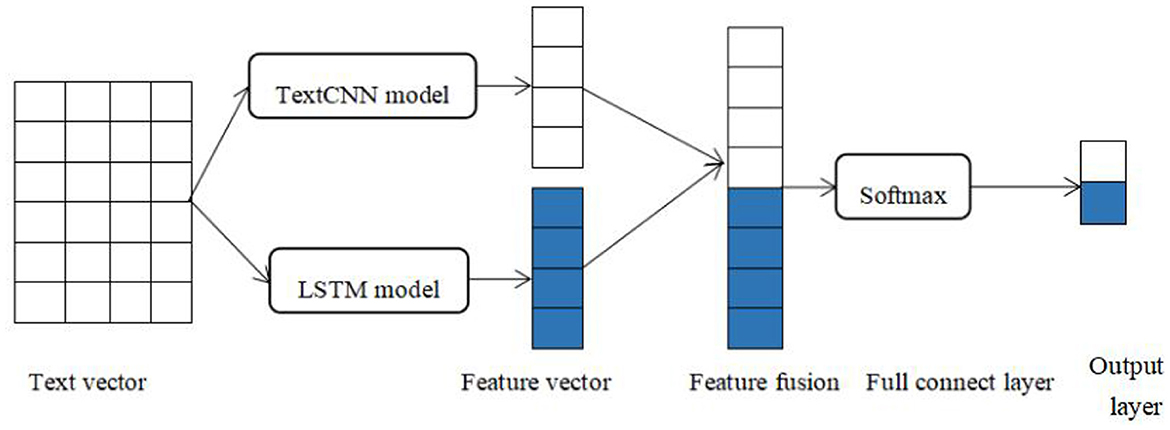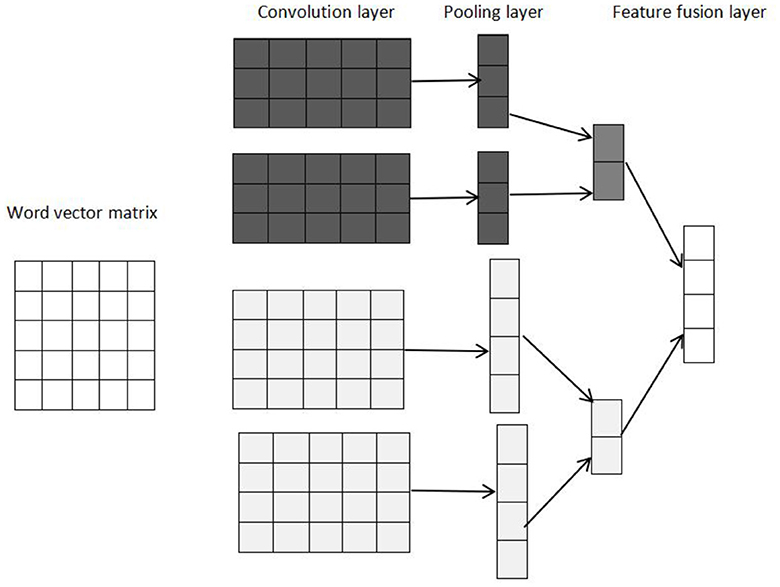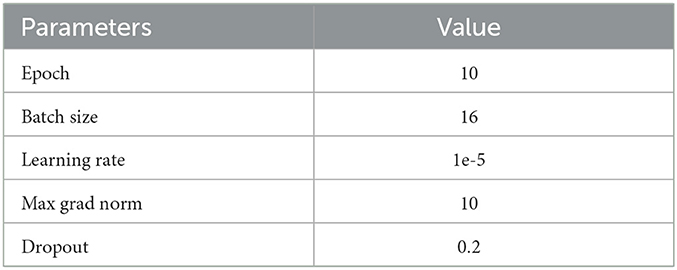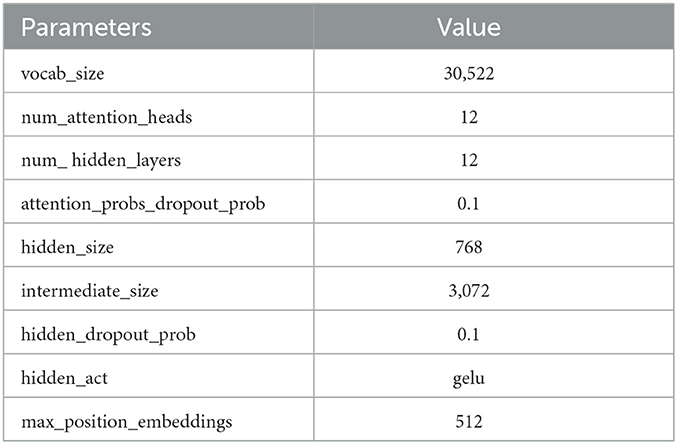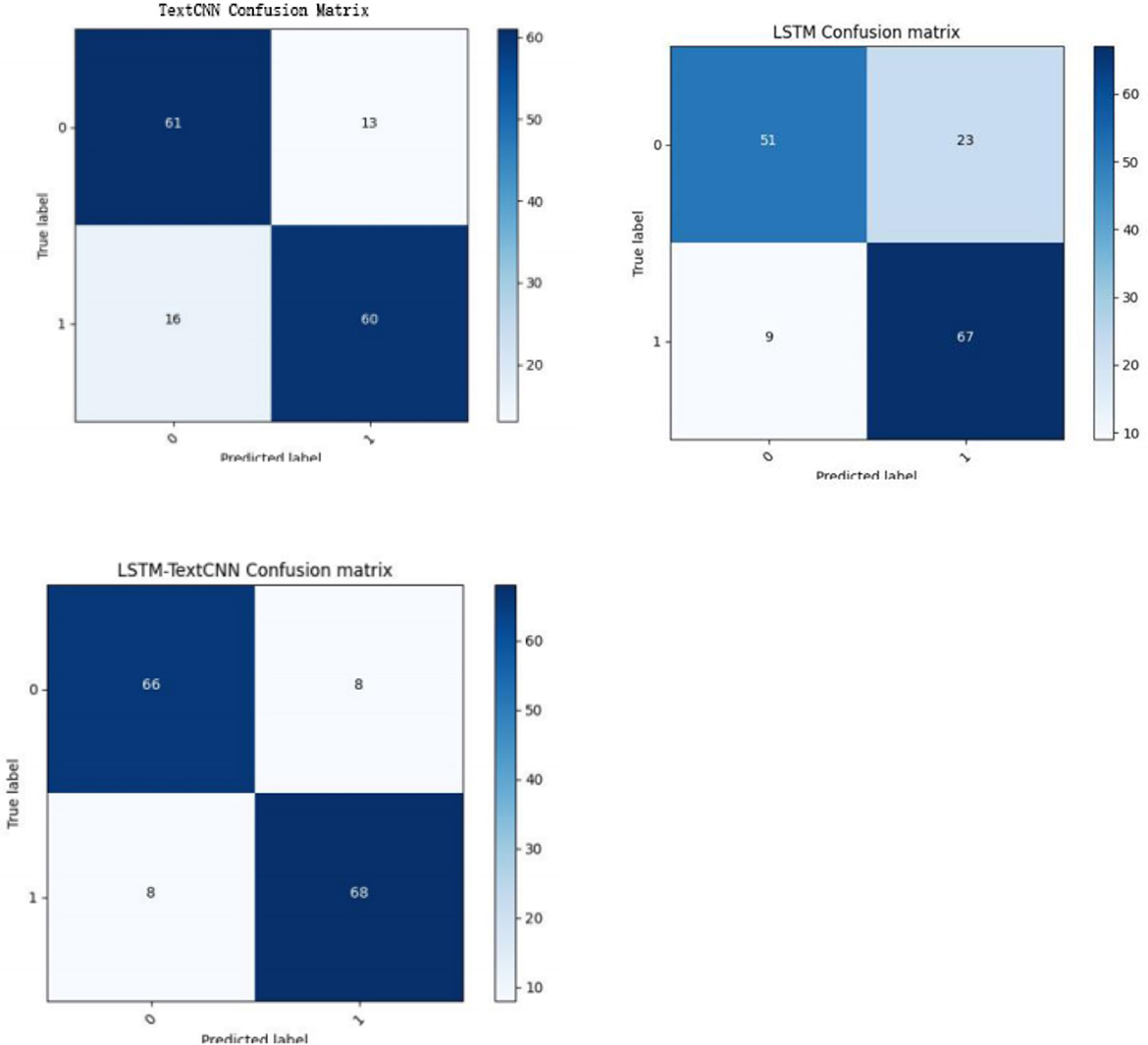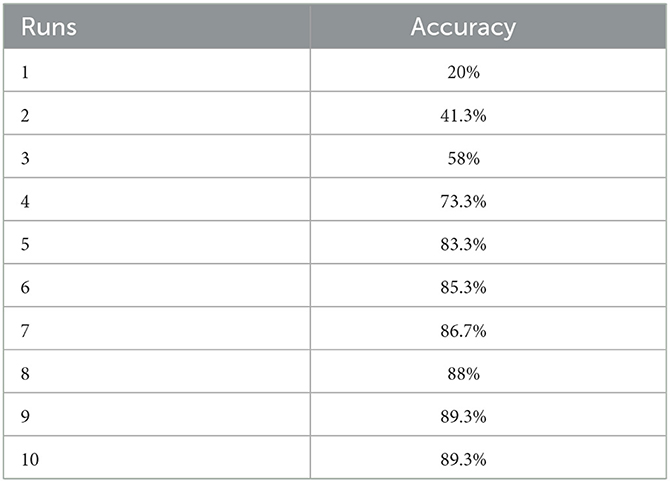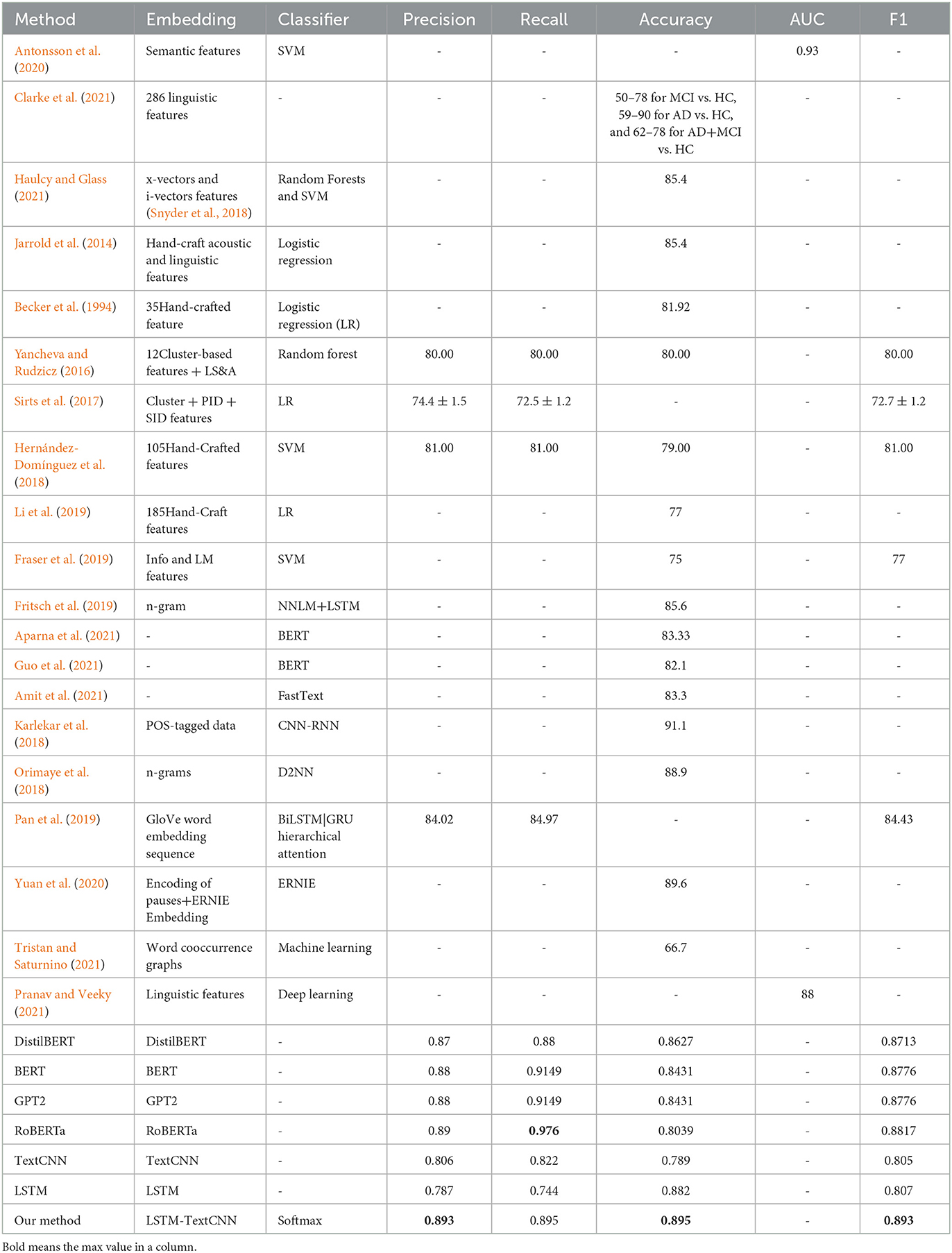- 1School of Science/School of Big Data Science, Zhejiang University of Science and Technology, Zhejiang, China
- 2Department of Neurology, Second Affiliated Hospital of Fujian Medical University, Quanzhou, Fujian, China
Introduction: Alzheimer's Disease (AD) is a common dementia which affects linguistic function, memory, cognitive and visual spatial ability of the patients. Language is proved to have the relationship with AD, so the time that AD can be diagnosed in a doctor's office is coming.
Methods: In this study, the Pitt datasets are used to detect AD which is balanced in gender and age. First bidirectional Encoder Representation from Transformers (Bert) pretrained model is used to acquire the word vector. Then two channels are constructed in the feature extraction layer, which is, convolutional neural networks (CNN) and long and short time memory (LSTM) model to extract local features and global features respectively. The local features and global features are concatenated to generate feature vectors containing rich semantics, which are sent to softmax classifier for classification.
Results: Finally, we obtain a best accuracy of 89.3% which is comparative compared to other studies. In the meanwhile, we do the comparative experiments with TextCNN and LSTM model respectively, the combined model manifests best and TextCNN takes the second place.
Discussion: The performance illustrates the feasibility to predict AD effectively by using acoustic and linguistic datasets.
1 Introduction
As we know, Alzheimer's disease (AD) is a chronic and progressive disease, and the group of people with AD is expanding with the increase in the aging population. Longfei et al. (2020) reported that there were 15.07 million people over 60 years old suffering from dementia in China in 2020, including 9.83 million AD patients and 3.92 million vascular dementia. Meanwhile, there are over half a billion AD patients in America nowadays1. AD has become a worldwide problem, and it is estimated that there will be approximately 7.6 billion patients falling ill with AD or other dementias by 2030. Although clinicians can differentiate AD people from healthy controls by a combination of cognitive test scales (Mesulam et al., 2012), it is usually time-consuming and inaccurate. Therefore, it is essential to develop a more reliable but simple method to differentiate different cognitive impairments, especially for the early diagnosis of AD.
A precious study in this area mainly includes two methods. The first one is feature extraction manually combined with machine learning to recognize AD properly, and it usually needs expertise and knowledge in order to extract more distinguishing features, so the accuracy and integrity of features cannot be guaranteed. The second one is deep learning, which uses a powerful deep learning model with multiple hidden layers without feature engineering, and a deep neural network can learn feature representations from datasets by using cascades of multilevel non-linear processing units for feature extraction. Moreover, the performance of deep learning is usually better than the first method, but the interpretability of the second method is poor.
The first method includes the conventional linguistic features extraction manually and the machine learning method. For example, Fraser et al. (2016) extracted mel-frequency cepstral coefficient (MFCC) features (Chen et al., 2014) on Pitt datasets, and this method was the first to carry out acoustic-prosodic analysis to recognize AD patients. Roark et al. (2011) employed natural language processing (NLP) and automatic speech recognition (ASR) to differentiate mild cognitive impairment (MCI) from healthy controls (HC), and the extracted features included pause frequency and duration. Finally, they used the SVM classifier combining the extracted features and yielded the best area under curve (AUC) of 0.861 by combining automated speech, linguistic features, and cognitive test scores. Zehra et al. (2021) extracted graph-based features encoding patterns and speech rate (Luz, 2013) from the Carolina Conversations Collection (Pope and Davis, 2011) and employed a logistic regression classifier to achieve a best accuracy of 85% when distinguishing AD from NC. Guo et al. (2021) extracted low-level acoustic features such as the number of utterances, speech rate, and vocal events, then employed the Bayesian classifier to train on low speech datasets extracted from the recordings, and finally obtained an accuracy of 68% for classifying AD and older adults controls. Antonsson et al. (2020) measured semantic ability quantitatively and employed the support vector machine (SVM) to recognize AD from NC, and the area under curve (AUC) value is 0.93. Clarke et al. (2021) measured 286 linguistic features to train the SVM model, and the final accuracy is 62–78% for AD+MCI vs. HC, 59–90% for AD vs. HC, and 50–78% for MCI vs. HC. Shamila et al. (2021) investigated conversational features such as disfluency, overlap, pause, and other elements in AD detection and employed Carolinas Conversations Collection Classifier (Zehra et al., 2021), and finally achieved an accuracy of 90% on Alzheimer's Dementia Recognition through Spontaneous Speech (ADReSS) datasets. Jarrold et al. (2014) extracted acoustic and linguistic features combined with the logistic regression classifier and achieved the best accuracy of 85.4% on DementiaBank datasets. Haulcy and Glass (2021) extracted features of x-vectors and i-vectors (Snyder et al., 2018) for tackling AD detection and phonetic features and obtained an accuracy of 85.4% in AD detection with SVM and random forest classifier.
In recent years, the deep learning method for AD diagnosis has become popular. For example, Aparna et al. (2021) pretrained the Bidirectional Encoder Representations from Transformers (BERT) model to recognize AD with ADReSS datasets and finally obtained an accuracy of 83.33%, which is better than feature extraction manually. The study (Chen et al., 2019) proposed an attention network composed of GRU and CNN modules and obtained an accuracy of 97% in distinguishing AD from normal controls. Amit et al. (2021) used the fastText and CNN models to recognize AD, respectively, and the fastText model obtained a best of 83.3% accuracy which is better than the performance of acoustic and linguistic features manually. The study (Fritsch et al., 2019) trained the LSTM model with the n-gram language model and obtained the best accuracy of 85.6%. Guo et al. (2021) used the BERT model on ADReSS and DementiaBank datasets and also obtained a competitive result.
The Text Convolutional Neural Network (TextCNN) was first proposed by Kim (2014) in the CV field in 2014, and the model used the convolution windows of different sizes to extract the local semantic information from the text vector and obtained the text representation after the pooling layer and fully connected layer; finally, they made a classification after the Softmax classifier. TextCNN has a better performance in many text classification tasks. For example, Kalchbrenner et al. (2014) proposed a dynamic convolutional neural network (DCNN) model that used dynamic K-max pooling in the pooling layer to obtain better adaptability for sentence modeling. Zhang et al. (2015) proposed a CNN text classification model with the character level, and the model can achieve an ideal classification effect without syntactic and semantic information. Compared with TextCNN, the module is more robust when faced with typos and emoticons. Liu and Guo (2019) extracted features for text sequence by using LSTM and the attention mechanism which could understand the contextual semantics of text. Although TextCNN learned the features of text sequences, it could only capture shallow meanings and was unable to mine deep semantic information. However, as far as we know, TextCNN was not applied to AD diagnosis by transcript.
With the development of science and technology, as well as the enhancement of computing power, large-scale pretrained language models have developed rapidly. In 2018, Devlin et al. (2019) introduced BERT, a self-coding language model that swept the natural language processing (NLP) tasks and redefined several records in this field. The BERT model used the multi-layer encoder of a bidirectional transformer and first proposed the next sentence prediction task and sentence mask innovatively. In this study, we propose a deep learning model that combines TextCNN and LSTM. The extracted features consider both short-term and long-term features. At last, we obtained the best accuracy of 89.3%, which is more competitive than other studies. The performance is better than the TextCNN and LSTM models, respectively, which means the extracted features are more comprehensive than both models. We also list many studies in this area with deep learning and machine learning methods, and the performance of our study is the most competitive. The contributions of this study are as follows:
- To propose a novel deep learning model combining TextCNN with LSTM for the diagnosis of AD.
- To build a model with excellent classification performance in a challenging scenario.
- To compare the proposed model with other machine learning and deep learning models to detect AD using short-term and long-term features obtained from transcripts.
2 Materials
2.1 Pitt corpus
The data used in this study is obtained from the DementiaBank website (https://sla.talkbank.org/TBB/dementia/English/Pitt) (Becker et al., 1994). Figure 1 is a cookie theft picture from the Boston Aphasia Examination (Chen et al., 2019), which was designed by Goodglass and Kaplan in 1972. The experiment is processed in a quiet room, where the participant is shown the picture and asked to describe the picture as detailed as possible (Figure 2), and it is a natural conversation between the doctor and the participant without tips during the process. Then, the corpus is transcripted through the CLAN system (Lin and Chen, 2018), which is a language manage software for transcribing the speech into professional datasets through recording, word segmentation, and parts-of-speech (POS) tagging. The transcripts from voice recordings were gathered from the School of Medicine at the University of Pittsburgh. Every audio file is associated with a transcript; 498 participants in this study were enrolled and obtained the corresponding transcripts after data pre-processing, including 256 people with probable and possible AD and 242 normal controls. The demographic information is shown in Table 1.
An example of the datasets from Pitt datasets is shown below:
a little boy is stepping on a ladder that's cockeyed. and the ladder has it's a tripodal it isn't a ladder it's a stool. and it's a a three legged stool. and he's getting cookies outof a jar. and he's handing a cookie to the little girl who's saying “shho” to the mother. and the mother is wiping dishes with water running all over the kitchen floor. and 1pause1. oh god. oh she's she has an open window. and there are bushes in front of the window either in the house next door or some place else. and then there's a tree that doesn't have a trunk.. and. there are two cups and the handles are in opposite directions. and she's sort of dumb because she doesn't turn off the water. she's letting it run on her feet. and half of the kitchen cupboard doors don't have handles. 1pause1. I don't think. and she's wiping the dish with two towels. and she isn't watching her dear darling children fall off the stool. okay isn't that about enough? [sic]
3 Methods
3.1 TextCNN
TextCNN is particularly effective in extracting short-term features or local patterns from datasets, and it has become an important feature extractor. The window sliding of TextCNN has no sequence relationship, different convolution kernels do not influence each other; therefore, it has a very high parallel degree. Compared with the traditional Bag-of-Words (BoW) model, TextCNN may be considered more effective in extracting text sequence features (Li et al., 2023). TextCNN includes four layers: convolution layer, pooling layer, fusion layer, and fully connected layer. The model has four filters to obtain multiple features which form the penultimate layer, we extract the linguistic features by convolution operation, the convolution kernel of which only convolution along the time step sequence, the width of every convolution kernel is the same as the dimension of the word vector, mainly for ensuring that the convolution kernel processes the word vector every time, the output is the eigenvector we need. This is the process by which TextCNN extracts features. After the convolution layer, the model extracted the most significant features by the max-pooling layer that can reduce dimension. Finally, a fully connected layer is added to finish the text classification task.
3.2 LSTM
A gate mechanism is designed by LSTM to control the flow of information in the network. The gate mechanism consists of specialized neurons that decide which information should be retained or forgotten and where to incorporate the retained information into the next moment. In order to solve the problem of gradient explosion and long-range information disappearance existing in RNN effectively, the LSTM model deals with a long-term dependence based on time series through the operation of three gates, which is crucial for understanding semantics and capturing long-distance features. LSTM is particularly suitable for the linear sequence application scenario of NLP, which makes it so popular in the natural language process (NLP) field.
3.3 LSTM-TextCNN
LSTM-TextCNN is the combination of LSTM and TextCNN models. The LSTM model can capture long-term dependencies in sentences, establish hidden states in the sequence, and improve the ability of information fusion in the sequence. The TextCNN model can capture local features effectively and calculate in parallel to reduce the computational complexity. The local features extracted from the TextCNN model and the long-distance features from the LSTM model are connected as the input of the next fully connected layer. Specifically, the overall framework of our model is shown in Figure 3.
3.3.1 Input layer
Convert words into vectors using the BERT pre-training model and form a sequential vector as the input.
3.3.2 LSTM layer
Learn information about long-term dependencies and hidden states in sequences.
3.3.3 TextCNN layer
Learn local features and extract key features related to classification.
3.3.4 Model combination
The output vector of the LSTM layer and TextCNN layer is concatenated before the Softmax classifier to get the final feature vectors.
3.4 BERT embedding
We fine-tuned the trained BERT base (Devlin et al., 2018), which includes 12-layer, 12-heads, 768-hidden, and 110M parameters. In particular, we used BERT-base uncased, where uncased means that the text has been lower-cased before WordPiece tokenization.
3.5 Local features extraction from TextCNN
The local features of the text are extracted by the TextCNN model, the model structure of which is shown in Figure 4. TextCNN is mainly composed of the convolution layer and pooling layer.
In the convolution layer, it first does a convolution operation with convolution kernels of different sizes, and different sizes of convolution kernels represent different receptive fields in order for richer local semantic information. Every convolution kernel scans the input text vector from BERT embedding to obtain the feature vector. In order to improve the expression of the model, the text features extracted by the convolution operation can be transformed by the activation function, and we choose the ReLU function as the activation function because it has a high convergence rate and can solve the problem of gradient disappearance. Then, the TextCNN model further reduces the feature dimension by a max-pooling operation. The pooling layer makes the model pay more attention to the most important features, reduces the feature dimension and the number of parameters, and prevents the occurrence of overfitting to a certain extent. At last, we obtain the final feature vectors by feature fusion layer.
3.6 Global features extraction from LSTM
LSTM is a variant of recurrent neural network (RNN) that can learn long periods of dependence. It relies on the structure of some “gates” to allow information to affect the state of each moment selectively and can decide which information should be forgotten or reserved effectively; therefore, LSTM can obtain long distance feature relationships of text sequences. It can remember the past information and also can solve the problem of gradient disappearance in RNN. The global features extracted from the LSTM model, combined with the local features, are used for text classification ultimately, so it is not necessary to collect the output of the model at every moment, but only the output of the last moment of the model, as it includes richer contextual semantic information.
3.7 Features fusion module
In the TextCNN model, feature regions with different sizes are extracted by setting different sizes of convolution kernels. However, TextCNN cannot still obtain the dependency between features of different texts due to the particularity of the text, and the features obtained cannot represent the whole text to a certain extent. The memory mechanism of LSTM has great advantages in processing long-term text information, and it can remember past information well. Therefore, we fused both the local and global features in order to obtain the final feature vectors.
The common feature fusion methods include concatenation, bit addition, and average. The original linguistic features can be preserved effectively, and the feature loss is avoided just by concatenating feature vectors simply. Therefore, this study chooses to concatenate the local features extracted from the TextCNN model and global features from the LSTM model into a feature vector. Assume that the feature extracted by the TextCNN model is Fl, and the feature extracted by the LSTM model is Fg, and the two features are spliced into a new feature F. Therefore, the feature vector F contains both the local features and the whole features of the text, and then F can be expressed as
Where ⊕ represents vector concatenate operation.
3.8 Classification result
The fused features need to be passed into the fully connected layer first, and the Softmax classifier is used for the classification task. The dimension of the output vector must be the same as the number of categories (2 in this study) in the classification. Finally, we used the feature vector F to do the classification;
where F represents the features after fusion, Wc is the parameter, bc is the bias, and y represents the classification result.
3.9 Hyperparameter setting
The experiment uses an Intel Core i5 8300H quad-core eight-thread CPU, 4 GB NVIDIA GTX 1050Ti for graphics, Python 3.7 for programming language, and Pytorch 1.7.1+cu101 for deep learning framework. The experiment is completed under the deep learning framework Keras, and we chose the BERT open-source library Pytorch Transformers and the BERT-Base pre-training model, which was released by Google. All the models used in this study are downloaded from the website of Hugging Face (https://huggingface.co/models?pipeline_tag=sentence-similarity&sort=downloads) via API (AutoModel.from_pretrained, AutoTokenizere.from_pretrained). The parameters of the training process are shown in Table 2.
Table 3 shows the parameters of the BERT-base used in this study.
In the TextCNN model, the dimension of the input vector is 260, the size of four convolution layers in the TextCNN model is 5, 10, 15, and 20, respectively, and the number of convolution layer is half of the average text length (130). In the LSTM layer, the number of units with 260 maximum text length is set to return the output of the last time step. ReLU and AdamW are the activation function and the optimizer, respectively, where W stands for weight decay, and it can adapt to adjust the learning rate of each parameter with good convergence and robustness. All models in the experiment added dropout methods to the FC layer, which dropped 50% of the neurons in order to avoid overfitting. The loss function is the cross entropy which can enable the learning rate of the model controlled by the output error, and the convergence speed is fast which can avoid the problem of low learning rate effectively and keep the model from falling into the local optimal solution. The formula for cross-entropy is shown below:
where C is the cost, x is the actual input, a is the actual output, y indicates the expected output, and n is the total number of inputs.
We divided the datasets into the training sets and testing sets by a proportion of 7:3, i.e., the number of which is 348 and 150, respectively. We perform 10 consecutive runs for every classifier and obtain the best performance on the results, and the prediction result is compressed between (0,1) for AD classification.
4 Results and discussion
4.1 Evaluation metrics
According to the medical clinical diagnosis, the positive result represents the individual with AD and the negative result represents the healthy one. Table 4 shows the relationship between the true class and the predicted class. We can obtain our basic indicators: true-positive (TP), false-positive (FP), false-negative (FN), and true-negative (TN), and these four indicators are presented in Table 4. As the datasets in two classifications are balanced (242 and 256), we choose the accuracy and confusion matrix to evaluate the performance of the LSTM, TextCNN, and LSTM-TextCNN models on the datasets. The accuracy is derived from the confusion matrix:
In the field of machine learning, a confusion matrix is a specific matrix used to visualize the performance of the model. Each row represents the predicted value, and each column is the actual category. In Table 4, TP and TN are the number of samples that are classified correctly by the classifier, so TP+TN is the number of samples classified correctly. Therefore, from Figure 5, we know that of the 150 testing sets, the correct predicted number in the TextCNN, LSTM, and LSTM-TextCNN models is 121(61+60), 118(51+67), and 134(66+68), respectively. According to the formula (6), the accuracy of the three models is 121/150 = 80.7%, 118/150 = 78.7%, and 134/150 = 89.3%, respectively, so the performance of the three models is LSTM-TextCNN > TextCNN > LSTM. The LSTM-TextCNN model has a better performance than the single model mainly because the combined models can integrate different text features extracted from the two models, and the fused features can represent the text more precisely.
The accuracy of the TextCNN-LSTM model in 10 runs is shown in Table 5, and the reason for 10 runs is that the performance of the model has become stable gradually after 9 runs.
We compare the performance of different machine learning and deep learning models on DementiaBank datasets, and the performance is shown in Table 6; the first eleven rows are the classification matrices with the machine learning method and the remaining rows are matrices with the deep learning method.
5 Conclusion
This study used the combination of the TextCNN and LSTM model to recognize AD from normal controls (NC), which can combine the advantages of the TextCNN model and LSTM model. First, we pretrained the datasets by the BERT model to obtain the word embedding vector and then used TextCNN to extract local features of different sizes and the LSTM model to obtain the global features. The TextCNN model only obtains the local features of the text, while the LSTM model can obtain the longer features, and the combination of both models can represent the whole text to a certain extent. Therefore, we concatenated the features from the TextCNN layer and LSTM layer to get the feature representation of the entire text, which were put into a Softmax classifier to obtain the classification result. Finally, three models were tested and compared with the evaluation metrics. The experiment results showed that the accuracy was 0.893 which was significantly higher than the LSTM and TextCNN model.
Differences in oral language may supply a tool to differentiate AD for older adults subjects based on the deep learning model, so our study is meaningful in developing a simple but practical, low-cost reliable tool for the early detection of AD or other dementia disease in future based on transcripts of narrative speech. We hope the tool can detect the change of AD gradually with the development of the disease in real time. Based on the above considerations, we believe the use of deep learning method to diagnose AD is an exploring and compelling area for further research study.
Data availability statement
The original contributions presented in the study are included in the article/supplementary material, further inquiries can be directed to the corresponding author.
Ethics statement
The manuscript presents research on animals that do not require ethical approval for their study. Written informed consent was obtained from the individual(s) for the publication of any potentially identifiable images or data included in this article.
Author contributions
NL: Validation, Writing—original draft. LW: Resources, Supervision, Writing—review & editing.
Funding
The author(s) declare that no financial support was received for the research, authorship, and/or publication of this article.
Conflict of interest
The authors declare that the research was conducted in the absence of any commercial or financial relationships that could be construed as a potential conflict of interest.
Publisher's note
All claims expressed in this article are solely those of the authors and do not necessarily represent those of their affiliated organizations, or those of the publisher, the editors and the reviewers. Any product that may be evaluated in this article, or claim that may be made by its manufacturer, is not guaranteed or endorsed by the publisher.
Footnotes
References
Amit, M., Anoop, C. S., and Ganesan, R. A. (2021). Recognition of Alzheimer's dementia from the transcriptions of spontaneous speech using fasttext and CNN models. Front. Comp. Sci. 3, 1–8. doi: 10.3389/fcomp.2021.624558
Antonsson, M., Fors, K. L., Eckerstrm, M., and Kokkinakis, D. (2020). Using a discourse task to explore semantic ability in persons with cognitive impairment. Front. Aging Neurosci. 12, 607449. doi: 10.3389/fnagi.2020.607449
Aparna, B., Benjamin, E., Jessica, R., Frank, R., and Jekaterina, N. (2021). Comparing pre-training and feature-based models for prediction of Alzheimer's disease based on speech. Front. Aging Neurosci. 13, 635945. doi: 10.3389/fnagi.2021.635945
Becker, J., Boller, F., Lopez, O., Saxton, J., and McGonigle, K. (1994). The natural history of Alzheimer's disease: Description of study cohort and accuracy of diagnosis. Arch. Neurol. 51, 585–594. doi: 10.1001/archneur.1994.00540180063015
Chen, J., Wang, Y., and Wang, D. (2014). A feature study for classificationbased speech separation at low signal-to-noise ratios. IEEE/ACM Trans. Audio Speech Lang. Proc. 22, 1993–2002. doi: 10.1109/TASLP.2014.2359159
Chen, J., Zhu, J., and Ye, J. (2019). “An attention-based hybrid network for automatic detection of Alzheimer's disease from narrative speech” in Interspeech 2019 (Graz).
Clarke, N., Barrick, T. R., and Garrard, P. (2021). A comparison of connected speech tasks for detecting early Alzheimer's disease and mild cognitive impairment using natural language processing and machine learning. Front. Comp. Sci. 3, 1–12. doi: 10.3389/fcomp.2021.634360
Devlin, J., Chang, M. W., Lee, K., and Toutanova, K. (2018). BERT: Pre-training of Deep Bidirectional Transf-ormers for Language Understanding 2018.
Devlin, J., Chang, M. W., Lee, K., and Toutanova, K. (2019). “BERT: Pre-training of deep bidirectional transformers for language understanding” in Proceedings of the 2019 Conference of the North American Chapter of the Association for Computational Linguistics: Human Language Technologies, Volume 1 (Long and Short Papers) (Stroudsburg, PA: Association for Computational Linguistics), 4171–4186.
Fraser, K. C., Linz, N., Li, B., Fors, K. L., Rudzicz, F., Konig, A., et al. (2019). “Multilingual prediction of Alzheimer's disease through domain adaptation and concept-based language modelling” in Proceedings of the 2019 Conference of the North American Chapter of the Association for Computational Linguistics: Human Language Technologies, Volume 1 (Long and Short Papers) (Minneapolis, MN: Association for Computational Linguistics), 3659–3670.
Fraser, K. C., Meltzer, J. A., and Rudzicz, F. (2016). Linguistic features identify Alzheimer's disease in narrative speech. J. Alzheimers Dis. 49, 407–422. doi: 10.3233/JAD-150520
Fritsch, J., Wankerl, S., and Noth, E. (2019). “Automatic diagnosis of alzheimer's disease using neural network language models” in ICASSP 2019-2019 IEEE International Conference on Acoustics, Speech and Signal Processing (ICASSP). 5841–5845.
Guo, Y., Li, C. Y., Carol, R., Serguei, P., and Trevor, C. (2021). Crossing the “Cookie Theft” corpus chasm: applying what BERT learns from outside data to the ADReSS challenge dementia detection task. Front. Comp. Sci. 3, 1–10. doi: 10.3389/fcomp.2021.642517
Haulcy, R., and Glass, J. (2021). Classifying Alzheimer's disease using audio and text-based representations of speech. Front. Psychol. 11, 624137. doi: 10.3389/fpsyg.2020.624137
Hernández-Domínguez, L., Ratt,é, S, Sierra-Martínez, G., and Roche-Berguac, A. (2018). Computer-based evaluation of Alzheimer's disease and mild cognitive impairment patients during a picture description task. Alzheimer's Dement. Diagn. Assess. Dis. Monit. 10, 260–268. doi: 10.1016/j.dadm.2018.02.004
Jarrold, W., Peintner, B., Wilkins, D., Vergryi, D., Richey, C., Gorno-Tempini, M. L., et al. (2014). Aided diagnosis of dementia type through computer-based analysis of spontaneous speech. CLPsych 2014, 27–37. doi: 10.3115/v1/W14-3204
Kalchbrenner, N., Grefenstette, E., and Blunsom, P. (2014). “A convolutional neural network for modelling sentences,” in Proceedings of the 52nd Annual Meeting of the Association for Computational Linguistics (Volume 1: Long Papers) (Baltimore, MD: Association for Computational Linguistics), 655–665. doi: 10.3115/v1/P14-1062
Karlekar, S., Niu, T., and Bansal, M. (2018). “Detecting linguistic characteristics of alzheimer's dementia by interpreting neural models” in Proceedings of the 2018 Conference of the North American Chapter of the Association for Computational Linguistics: Human Language Technologies, Volume 2 (Short Papers) (New Orleans, LA), 701–707.
Kim, Y. (2014). “Convolutional neural networks for sentence classification” in Proceedings of the 2014 Conference of Empirical Methods in Natural Language Processing (Stroudsburg, PA: Association for Computational Linguistics), 1746–1751.
Li, B., Hsu, Y. T., and Rudzicz, F. (2019). Detecting dementia in mandarin Chinese using transfer learning from a parallel corpus. arXiv [preprint] arXiv:1903.00933. doi: 10.18653/v1/N19-1199
Li, F., Wang, F., and Huang, S. (2023). Research on Chinese text classification based on Albert and TextCNN. Software Guide22, 27–31.
Lin, F., and Chen, Z. (2018). Summary of Clinical Research Application of CLAN. (Nanjing: Rehabilitation Medicine, Nanjing Medical University), 1–34.
Liu, G., and Guo, J. (2019). Bidirectional LSTM with attention mechanism and convolutional layer for text classification. Neurocomputing 337, 325–338. doi: 10.1016/j.neucom.2019.01.078
Longfei, J., Yifeng, D., Lan, C., Zhang, Z., Li, F., Lyu, D., et al. (2020). Prevalence, risk factors, and management of dementia and mild cognitive impairment in adults aged 60 years or older in China: a cross-sectional study. Lancet Public Health 5, e661–e671. doi: 10.1016/S2468-2667(20)30185-7
Luz, S. (2013). Automatic identifification of experts and performance prediction in the multimodal math data corpus through analysis of speech interaction. Procs. ICMI. ACM 2013, 575–582. doi: 10.1145/2522848.2533788
Mesulam, M. M., Wieneke, C., Thompson, C., Rogalski, E., and Weintraub, S. (2012). Quantitative classification of primary progressive aphasia at early and mild impairment stages. Brain 135, 1537–1553. doi: 10.1093/brain/aws080
Orimaye, S. O., Wong, S. M., Wong, C. P., and Liang, P. (2018). Deep language space neural network for classifying mild cognitive impairment and Alzheimer-type dementia. PLoS ONE.13, e0205636. doi: 10.1371/journal.pone.0205636
Pan, Y., Mirheidari, B., Reuber, M., Venneri, A., Blackburn, D., and Christensen, H. (2019). Automatic hierarchical attention neural network for detecting AD. Proc. Interspeech 2019,:4105–4109. doi: 10.21437/Interspeech.2019-1799
Pope, C., and Davis, B. H. (2011). Finding a balance: the carolinas conversation collection. Corpus Linguis. Linguis. Theory 7, 143–161. doi: 10.1515/cllt.2011.007
Pranav, M., and Veeky, B. (2021). Acoustic and language based deep learning approaches for alzheimer's dementia detection from spontaneous speech. Front. Aging Neurosci. 13, 623607. doi: 10.3389/fnagi.2021.623607
Roark, B., Mitchell, M., Hosom, J.-P., Hollingshead, K., and Kaye, J. (2011). Spoken language derived measures for detecting mild cognitive impairment. IEEE/ACM Trans. Audio Speech Lang. Proc. 19, 2081–2090, 2011. doi: 10.1109/TASL.2011.2112351
Shamila, N., Morteza, R., Julian, H., and Matthew, P. (2021). Alzheimer's dementia recognition from spontaneous speech using disfluency and interactional features. Front. Comp. Sci. 3, 1–15. doi: 10.3389/fcomp.2021.640669
Sirts, K., Piguet, O., and Johnson, M. (2017). Idea density for predicting Alzheimer's disease from transcribed speech. Alzheimers Dis. 2017, 322–332. doi: 10.18653/v1/K17-1033
Snyder, D., Garcia-Romero, D., Sell, G., Povey, D., and Khudanpur, S. (2018). “X-vectors: robust DNN embeddings for speaker recognition” in Procs IEEE International Conference on Acoustics, Speech and Signal Processing (ICASSP) (Calgary, AB: IEEE). 5329–5333.
Tristan, M., and Saturnino, L. (2021). Analysis and classification of word co-occurrence networks from Alzheimer's patients and controls. Front. Comp. Sci. 3, 649508. doi: 10.3389/fcomp.2021.649508
Yancheva, M., and Rudzicz, F. (2016). “Vector-space topic models for detecting Alzheimer's disease” in Proceedings of the 54th Annual Meeting of the Association for Computational Linguistics (Volume 1: Long Papers) (Berlin: ACL Press), 2337–2346.
Yuan, J., Bian, Y., Cai, X., Huang, J., and Church, K. (2020). “Disfluencies and fine-tuning pre-training language models for detection of Alzheimer's disease” in Interspeech 2020 (Shanghai).
Zehra, S., Jeffrey, S., Mashrura, T., Shi-ang, Q., Eleni, S., and Russell, G. (2021). Learning language and acoustic models for identifying Alzheimer's dementia from speech. Front. Comp. Sci. 3, 1–7. doi: 10.3389/fcomp.2021.624659
Keywords: Alzheimer's disease, natural language processing, linguistic features, deep learning, LSTM
Citation: Liu N and Wang L (2023) An approach for assisting diagnosis of Alzheimer's disease based on natural language processing. Front. Aging Neurosci. 15:1281726. doi: 10.3389/fnagi.2023.1281726
Received: 23 August 2023; Accepted: 17 October 2023;
Published: 16 November 2023.
Edited by:
Xudong Huang, Massachusetts General Hospital and Harvard Medical School, United StatesReviewed by:
Durai Raj Vincent P. M., VIT University, IndiaKazem Taghva, University of Nevada, Las Vegas, United States
Copyright © 2023 Liu and Wang. This is an open-access article distributed under the terms of the Creative Commons Attribution License (CC BY). The use, distribution or reproduction in other forums is permitted, provided the original author(s) and the copyright owner(s) are credited and that the original publication in this journal is cited, in accordance with accepted academic practice. No use, distribution or reproduction is permitted which does not comply with these terms.
*Correspondence: Lingxing Wang, bHhpbmc1MDJAZmptdS5lZHUuY24=
 Ning Liu
Ning Liu Lingxing Wang
Lingxing Wang